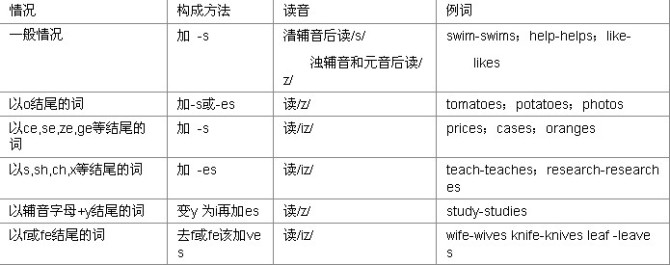定義
一般現在時。表示通常性、規律性、習慣性的狀態或者動作(有時間規律發生的事件)的一種時間狀態。
口訣
當主語是第三人稱單數時
肯定句 主語+動詞單三+其他
否定句 主語+doesn't+動詞原形+其他
一般疑問句 Does+主語+動詞原形+其他
肯定回答 Yes,主語+does
否定回答 No,主語+doesn't
特殊疑問句 特殊疑問詞+一般疑問句
當主語不是第三人稱單數時
肯定句 主語+動詞原形+其他
否定句 主語+don't+動詞原形+其他
一般疑問句 Do+主語+動詞原形+其他
用錯結構全句都錯,一定要注意。
具體用法
表示
1.表示經常的或習慣性的動作,常與表示頻率的時間狀語連用。
時間狀語:
always,usually,regularly,everymorning/night/evening/day/week,often,sometimes,occasionally,from time to time,twice a week,rarely,seldom,once a month, hardly, ever,never.
e.g. I leave home for school at 7:00 every morning.
.表示主語具備的性格、能力、特征和狀態。
e.g. I don't want so much.
Ann Wang writes good English but does not speak well.
比較:Now I put the sugar in the cup.
I am doing my homework now.
3.表示客觀事實和普遍真理。
e.g The earth moves around the sun.
Shanghai lies in the east of China.
4.在時間狀語從句和條件狀語從句中,常用一般現在時代替將來時。
5.表示預先計劃或安排好的行為。
6.小說故事用一般現在時代替一般過去時。新聞報道類的內容,為了體現其“新鮮”性,也用一般現在時來表示過去發生的事情。
7.有些表示狀態和感覺的動詞表示現在發生的具體行為時,只用一般現在時,而不用進行時態。
8.表示現在發生的具體動作或存在的狀態
9表示格言或警句中。
e.g Pride goes before a fall. 驕者必敗。
☆注意★:此用法如果出現在賓語從句中,即使主句是過去時,從句謂語也要用一般現在時。
例:Columbus proved that the earth is round.. 第一句用一般現在時,用于操作演示或指導說明的示范性動作,表示言行的瞬間動作。再如:Now watch me, I switch on the current and stand back. 第二句中的now是進行時的標志,表示正在進行的動作的客觀狀況,所以后句用一般現在時。
一般現在時表將來
1)下列動詞:come, go, arrive, leave, start, begin, return,live,fly的一般現在時表將來。這主要用來表示在時間上已確定或安排好的事情(即按照固定時間表將來發生的動作)。
The train leaves at six tomorrow morning. When does the bus start? It starts in ten minutes.
2)倒裝句,表示動作正在進行,如: Here comes the bus. = The bus is coming. There goes the bell. = The bell is ringing.
3)在時間或條件句中。 When Bill comes (不是will come), ask him to wait for me. I'll write to you as soon as I arrive there.
4)在動詞hope, take care that, make sure that等后。 I hope they have a nice time next week. Make sure that the windows are closed before you leave the room.
5).表示按規定、計劃或時間表將要發生的事。
He starts next week. 他下個星期出發。
We leave very soon. 我們很快就離開。
The train starts at 10 o'clock in the morning. 火車將在早上10點開出。
這類用法限于表示“移動”的動詞:go去,come來,leave離開,start出發,begin開始,arrive到達,take off起飛,等。
第三人稱單數變化規律

一般現在時基本構成表

|